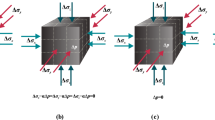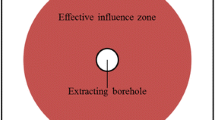Abstract
Bedding structure has affected gas flow in coal seam greatly, which also controls gas permeation direction and gas extraction results, and finally it has tremendous influence on prevention and control of gas disaster accidents. Combined with engineering practice of gas disaster prevention and control in China, in this paper, permeability evolution of nature coal in different bedding directions in the condition of loading is studied, and the results showed that in three directions of bedding fractures, permeability of coal which is parallel to bedding planes is the highest; it would be much easier for gas percolation along the bedding planes than other directions. In the unloading process, tension–shear destruction appears in coal sample which is oblique to bedding along the bedding planes, with a sudden increase in permeability. It is difficult for the crack damage from loading process to recover in unloading process, that is, permeability of unloading isn’t just a simple reverse process of loading. Combined with the permeability evolution of the three coal samples in the whole process, three permeability evolution models which include elasticity, plasticity and fracture are proposed. Based on the experimental results, gas extraction using boreholes along coal seam and through coal seam is compared during depressurized mining. Due to the bedding structure of coal seam, a large area of fracture network of “boreholes–bedding fractures” is formed among boreholes through coal seam and bedding structure, which makes the good effect of gas extraction using boreholes through coal seam. Research results will be of important guiding significance for choosing the best gas extraction scheme, layout of setting parameters of drilling boreholes and gas disaster prevention in the underground coal mine.














Similar content being viewed by others
References
Berryman JG (2011) Mechanics of layered anisotropic poroelastic media with applications to effective stress for fluid permeability. Int J Eng Sci 49:122–139
Chen J, Qin Y, Song Q, Song Z (2003) Coupling relationship between direction of coalbed cleat and methane drainage effect and its prediction model. Zhongguo Kuangye Daxue Xuebao (J China Univ Min Technol) 32:223–226
Cheng Y, Fu J, Yu Q (2009) Development of gas extraction technology in coal mines of China. J Min Saf Eng 26:127–139
Connell LD, Lu M, Pan Z (2010) An analytical coal permeability model for tri-axial strain and stress conditions. Int J Coal Geol 84:103–114
Dawson G, Esterle J (2010) Controls on coal cleat spacing. Int J Coal Geol 82:213–218
Durucan S, Edwards JS (1986) The effects of stress and fracturing on permeability of coal. Min Sci Technol 3:205–216
Fu X, Li D, Qin Y (2002) Experimental research of influence of coal matrix shrinkage on permeability. J China Univ Min Technol 31:129–131
Gash BW, Volz RF, Potter G, Corgan JM (1992) The effects of cleat orientation and confining pressure on cleat porosity, permeability and relative permeability in coal. Paper 9321:17–21
Harpalani S (1985) Gas flow through stressed coal. California University, Berkeley
Huang X (2012) Experimental study on influence of structural anisotropy of coal upon gas permeability. Min Saf Environ Prot 39:1–3
Jasinge D, Ranjith PG, Choi SK (2011) Effects of effective stress changes on permeability of Latrobe Valley brown coal. Fuel 90:1292–1300
Karacan CÖ, Mitchell GD (2003) Behavior and effect of different coal microlithotypes during gas transport for carbon dioxide sequestration into coal seams. Int J Coal Geol 53:201–217
Koenig R, Stubbs P (1986) Interference testing of a coalbed methane reservoir. In: SPE unconventional gas technology symposium, Louisville, Kentucky
Korsnes R, Risnes R, Faldaas I, Norland T (2006) End effects on stress dependent permeability measurements. Tectonophysics 426:239–251
Kuila U, Dewhurst D, Siggins A, Raven M (2011) Stress anisotropy and velocity anisotropy in low porosity shale. Tectonophysics 503:34–44
Laubach S, Marrett R, Olson J, Scott A (1998) Characteristics and origins of coal cleat: a review. Int J Coal Geol 35:175–207
Law B (1993) The relationship between coal rank and cleat spacing: implications for the prediction of permeability in coal. In: Proceedings of the 1993 international coalbed methane symposium, University of ALabama, Twscaloosa, ALabma
Li H, Ogawa Y, Shimada S (2003) Mechanism of methane flow through sheared coals and its role on methane recovery. Fuel 82:1271–1279
Li H, Shimada S, Zhang M (2004) Anisotropy of gas permeability associated with cleat pattern in a coal seam of the Kushiro coalfield in Japan. Environ Geol 47:45–50
Li J, Liu D, Yao Y, Cai Y, Chen Y (2013) Evaluation and modeling of gas permeability changes in anthracite coals. Fuel 111:606–612
Liu S, Harpalani S, Pillalamarry M (2012) Laboratory measurement and modeling of coal permeability with continued methane production: part 2—modeling results. Fuel 94:117–124
Majewska Z, Majewski S, Ziętek J (2013) Swelling and acoustic emission behavior of unconfined and confined coal during sorption of CO2. Int J Coal Geol 116–117:17–25
Mazumder S, Wolf KHAA, Elewaut K, Ephraim R (2006) Application of X-ray computed tomography for analyzing cleat spacing and cleat aperture in coal samples. Int J Coal Geol 68:205–222
McKee C, Bumb A, Koenig R (1988) Stress-dependent permeability and porosity of coal and other geologic formations. SPE Form Eval 3:81–91
Palmer I (2009) Permeability changes in coal: analytical modeling. Int J Coal Geol 77:119–126
Perera M, Ranjith P, Choi S (2013) Coal cleat permeability for gas movement under triaxial, non-zero lateral strain condition: a theoretical and experimental study. Fuel 109:389–399
Pomeroy C, Robinson DJ (1967) The effect of applied stresses on the permeability of a middle rank coal to water. Int J Rock Mech Min Sci Geomech Abstr. Elsevier, pp 329–343
Rose R, Foh S (1984) Liquid permeability of coal as a function of net stress. In: SPE unconventional gas recovery symposium, Pittsburgh, Pennsylvania
Ryan B, Branch NV (2002) Cleat development in some British Columbia coals. BC Minist Energy Mines 2003–2011
Somerton WH, Söylemezoḡlu IM, Dudley RC (1975) Effect of stress on permeability of coal. Int J Rock Mech Min Sci Geomech Abstr 12:129–145
Wang S, Elsworth D, Liu J (2011) Permeability evolution in fractured coal: the roles of fracture geometry and water-content. Int J Coal Geol 87:13–25
Yin S, Wang S (2006) Effect and mechanism of stresses on rock permeability at different scales. Sci China Ser D 49:714–723
Yu Y, Wang L, Li J (2008) Effect of impulse and bedding on impact toughness of coal. J Coal Sci Eng (China) 4:27–30
Yuan L, Qin Y, Cheng Y, Meng J, Shen J (2013) Scenario predication for medium–long term scale of coal mine methane drainage in China. J China Coal Soc 38:529–534
Zharikov A, Vitovtova V, Shmonov V, Grafchikov A (2003) Permeability of the rocks from the Kola superdeep borehole at high temperature and pressure: implication to fluid dynamics in the continental crust. Tectonophysics 370:177–191
Zhou J, Xian X, Jiang Y, Li X, Jiang D (2009) A permeability model considering the effective stress and coal matrix shrinking effect. J Southwest Pet Univ (Sci Technol Ed) 31:4–8
Acknowledgments
This work was carried out with funding from the National Basic Research Development Program of China (Grant No. 2011CB201204); and National Natural Science Foundation of China (Grant Nos. 51304070, 51074160, U1361205, 51204173). The authors wish to thank these two organizations for the support provided. They also wish to thank there viewers and editors for their constructive comments and suggestions in improving the manuscript.
Author information
Authors and Affiliations
Corresponding author
Rights and permissions
About this article
Cite this article
Pan, R., Cheng, Y., Yuan, L. et al. Effect of bedding structural diversity of coal on permeability evolution and gas disasters control with coal mining. Nat Hazards 73, 531–546 (2014). https://doi.org/10.1007/s11069-014-1086-7
Received:
Accepted:
Published:
Issue Date:
DOI: https://doi.org/10.1007/s11069-014-1086-7




